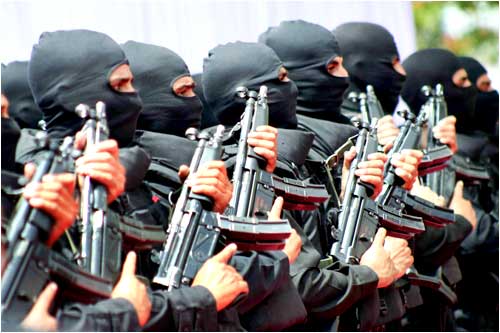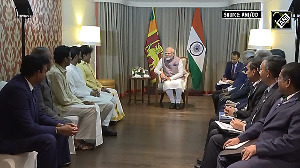
The National Security Guard has shifted around 900 of its commandos rendering VIP security duties for training in specialist counter-terror operations as part of its original charter.
The commando force, for the first time in many years, has de-inducted these 'black cats' from one of its three VIP security units -- the '11 Special Rangers Group' from its existing duties.
The formations of the NSG are segregated into five units, two Special Action Groups manned by officers and jawans from the Army and three SRGs comprising personnel from para-military forces.
"One unit has been de-inducted from rendering VIP security duties. They will now train to perform counter-terror tasks on the lines of the SAG units. Both the Army and paramilitary components will now be able to perform the mandated charter of the force which is to tackle terror and hijack challenges," an official said.
As per the current charter of the force, each of the two SAGs (51 and 52) is tasked for counter-terror and counter -- hijack operations respectively, while the SRGs (11,12 and 13) are used to render logistical support to the SAGs during operations and are deployed for guarding high-risk VIPs/VVIPs.
Each of these units has around 900 personnel each. The NSG, according to sources, has been able to accomplish the de-induction of the large number of commandos as after a long time it is guarding the least number of 15 VVIPs/VIPs.
The force has decided to use this opportunity to return to its original charter of performing counter-terror, counter-hijack, hostage rescue and sky-marshaling duties onboard aircrafts.
"The two other VIP security duty units are capable to cater to the present number of protectees that the force has under its responsibility now," the official said.
The NSG was raised under an Act of the Parliament in 1984 as a federal contingency force. The commandos of the SRG unit will now be given extensive training in counter-terror operations by the force commander and inspector general (training), both brigadier and major general rank officials of the NSG based at its garrison at Manesar in Gurgaon.
The plan, according to sources, is to raise the de-inducted squad by next year and once the training is done the commandos of this new unit would only perform combat-terror operations.
"Considering NSG's expansion to the new hubs and keeping in mind the emerging trends in terrorism, the force needs more strength of commandos to undertake counter-terror operations," a senior NSG official had said when the new blueprint for such a change was being drafted.
NSG commanders, according to the blueprint, foresee an event where simultaneous attacks could be launched at multiple centres in the country and then the commandos will have to be rushed in different directions.
"The 26/11 Mumbai attack involved some 400 commandos in three days. Considering we have multiple terror hits at one go, we need to have a good number of fighting commandos and some in the reserves to replace them," they had said.
The force also expects that with central paramilitary forces such as the Central Reserve Police Force, the Central Industrial Security Force and the Indo-Tibet Border Police increasingly taking the load of VIP security, it could, in some more time, cull out the 12
SRG in a similar fashion to be deployed for counter-terror operations.
The forces' charter says the primary role of NSG is 'to combat terrorism in whatever form it may assume in areas where activity of terrorists assumes serious proportions, and the state police and other Central police forces cannot cope up with the situation'.
"The NSG is a force especially equipped and trained to deal with specific situations and is therefore, to be used only in exceptional situations. The force is not designed to undertake the functions of state police forces or other paramilitary forces of the Union of India."
The NSG, when it was raised, was modelled on the pattern of foreign special forces such as Special Air Service of the UK and GSG-9 of Germany but it has now included the best practices of some other elite forces over the years for updated combat preparedness.











 © 2025
© 2025